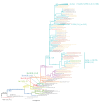Antigenic changes in influenza A(H3N2) driven by genetic evolution: Insights from virological surveillance, EU/EEA, week 40/2023 to week 9/2024
- PMID: 39668766
- PMCID: PMC11650508
- DOI: 10.2807/1560-7917.ES.2024.29.50.2400395
Antigenic changes in influenza A(H3N2) driven by genetic evolution: Insights from virological surveillance, EU/EEA, week 40/2023 to week 9/2024
Abstract
BackgroundDuring the 2023/24 influenza season in the European Union/European Economic Area (EU/EEA), influenza viruses A(H1N1)pdm09, A(H3N2) and B/Victoria viruses were co-circulating.AimWe aimed to describe the circulating influenza viruses by (sub)type, genetic clade, antigenic group and antiviral susceptibility in that season in the EU/EEA.MethodsWe collected surveillance data from EU/EEA countries through weekly submissions to The European Surveillance System (TESSy). Data were submitted in strain-based format for weeks 40/2023 to 9/2024.ResultsTwenty-nine EU/EEA countries reported 154,718 influenza virus detections (primary care sentinel and non-sentinel combined), of which 97% (150,692) were type A and 3% (4,026) were type B. Of the subtyped influenza A viruses, 30,463 (75%) were influenza A(H1)pdm09 and 10,174 (25%) were influenza A(H3). For 809 (20%) of the type B viruses, the lineage was determined; all were B/Victoria/2/87 lineage, and none were B/Yamagata/16/88 lineage. Genetic diversification of seasonal influenza viruses continued, and clade 5a.2a of A(H1N1)pdm09, 2a.3a.1 of A(H3N2) and V1A.3a.2 of B/Victoria-lineage viruses dominated. Of the A(H3N2) 2a.3a.1 viruses, 23% were antigenically distinct from the 2023/24 vaccine virus.ConclusionThe 2023/24 influenza season was characterised by co-circulation of different influenza (sub)types, antigenically similar to the components recommended for the 2023/24 northern hemisphere vaccine, A/Victoria/4897/2022 (egg-based) and A/Wisconsin/67/2022 (cell culture- or recombinant-based). However, genetic diversification of the viruses continued. The World Health Organization's vaccine recommendations for the northern hemisphere 2024/25 season were updated to include a new A(H3N2) component, while maintaining the current A(H1N1)pdm09 and B/Victoria components.
Keywords: Europe; genetic; influenza; surveillance.
Conflict of interest statement
Figures
References
-
- World Health Organization (WHO). Recommended composition of influenza virus vaccines for use in the 2024-2025 northern hemisphere influenza season. Geneva: WHO; 2024. Available from: https://www.who.int/publications/m/item/recommended-composition-of-influ...
-
- European Centre for Disease Prevention and Control (ECDC), World Health Organization European Region (WHO/Europe). Operational considerations for respiratory virus surveillance in Europe. Stockholm: ECDC; 2022. Available from: https://www.ecdc.europa.eu/en/publications-data/operational-consideratio...
-
- Aksamentov I, Roemer C, Hodcroft E, Neher R. Nextclade: clade assignment, mutation calling and quality control for viral genomes. J Open Source Softw. 2021;6(67):3773. 10.21105/joss.03773 - DOI
MeSH terms
Substances
Grants and funding
LinkOut - more resources
Full Text Sources


